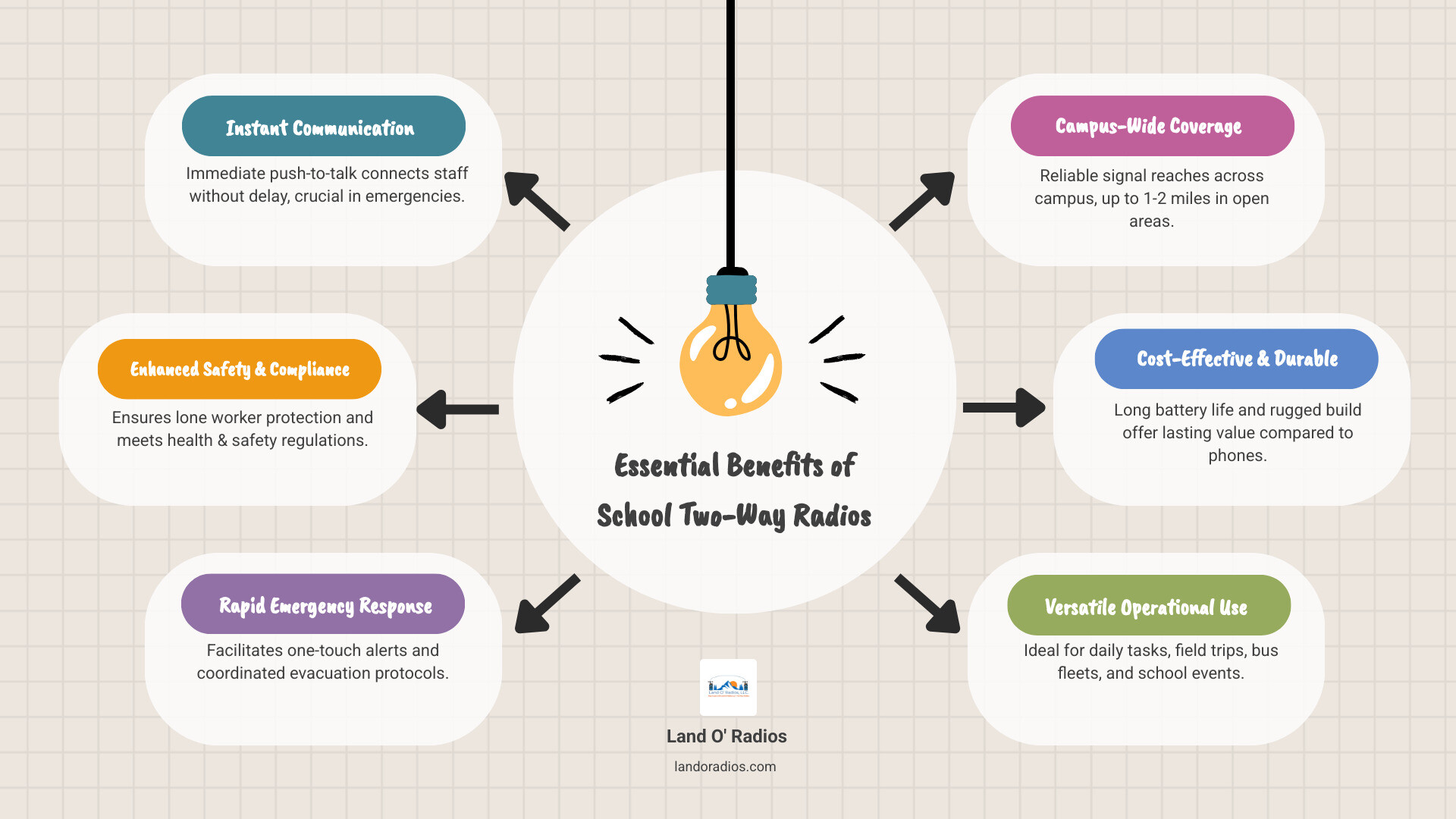Why Instant Communication is a Must-Have for Modern Schools
School two-way radios provide instant, reliable communication for teachers, administrators, security staff, and maintenance teams across your entire campus. Unlike mobile phones that can have connection delays, two-way radios deliver immediate push-to-talk communication when every second counts.
In an emergency, instant contact is non-negotiable. That's why health and safety bodies recognize two-way radios as the preferred communication method for educational settings. They are essential for complying with lone worker regulations and executing emergency evacuation protocols efficiently. From directing morning traffic to coordinating a crisis response, these tools are a critical safety requirement for modern schools.
Radios are vital for:
- Instant Emergency Response: One-touch alerts and campus-wide coordination.
- Health & Safety Compliance: Protecting lone workers and managing incidents.
- Efficient Daily Operations: Connecting staff across multiple buildings without delay.
- Reliable Coverage: Ensuring campus-wide connectivity, even in areas with poor cell service.
- Cost-Effective Communication: Durable devices with long-lasting batteries reduce long-term costs.
I'm Rene Fornaris, and with over ten years of experience at Advanced Radio Systems, I've helped countless schools find the perfect school two-way radios to keep staff connected and students safe. My goal is to help you steer the options and find a reliable solution that fits your campus needs and budget.

The Ultimate Guide to Choosing School Two-Way Radios
Choosing the right communication tools impacts everything from daily efficiency to emergency response. Whether you're managing a compact campus or a sprawling district, this guide will walk you through the essentials of selecting school two-way radios that keep your staff connected and your students safe.
Key Features to Look for in a School Radio
Professional school radios are built to perform when it matters most. Here’s what to prioritize:
- Durability and Ruggedness: School environments are tough on equipment. Look for radios built to military standards for shock, vibration, and temperature extremes. They need to be workhorses, not toys.
- Weather and Waterproofing: Your communication can't stop for a sudden downpour. An IP67 waterproof rating ensures a radio can survive dust and submersion in water. Combined with shock-resistance, these radios are built to last.
- All-Day Battery Life: Staff need reliable communication from the first bell to the last bus. Look for high-capacity batteries that offer up to 24 hours of life on a single charge, eliminating mid-day power failures.
- Campus-Wide Range: Your radios must work everywhere you need them. While licensed radios can cover a mile or more, concrete walls can block signals. For larger campuses, repeaters or digital systems may be needed to ensure seamless coverage.
- One-Touch Emergency Features: In a crisis, simplicity is key. One-touch emergency buttons instantly alert staff, while lone worker features can automatically signal for help if a user is unresponsive—critical for staff working alone.
- Clear Audio Quality: In a noisy cafeteria or during an emergency, messages must be understood. Digital radios excel at noise cancellation, delivering crisp audio. Despite these features, the best radios remain lightweight and easy to use with simple push-to-talk functionality.

Investing in radios with these features ensures your communication system is a reliable lifeline. To explore durable options, check out our selection of heavy-duty school radios or read more about radios worth your money.
Choosing the Right Radio Technology for Your Campus
Understanding the technology helps you make a future-proof decision.
Analog vs. Digital: What's the Real Difference?
| Feature | Analog Radios | Digital (DMR) Radios |
|---|---|---|
| Audio Quality | Can degrade with distance/interference | Clearer audio, even at range; better noise cancellation |
| Range | Similar physical range, but usable range can be less due to audio degradation | Better usable range with clearer audio at the fringes |
| Cost | Generally lower initial cost | Higher initial cost, but often lower long-term operating costs |
| Security | Limited privacy with basic scrambling | Improved privacy and encryption options |
| Features | Basic voice communication, simple group calls | Advanced features: text messaging, GPS, individual calls, remote monitoring, data applications |
Analog radios are simple and affordable, suitable for basic needs in a compact area. However, Digital (DMR) radios are the modern standard, offering superior audio, better range, and advanced features like text messaging and GPS. It's critical to note that these two technologies are not compatible—analog radios cannot communicate with digital radios. Therefore, a school must commit to one system. For most, DMR is the smarter long-term investment.
UHF vs. VHF: Finding Your Frequency
- UHF (Ultra High Frequency): Best for penetrating concrete and steel. This makes UHF the ideal choice for most schools, as it provides reliable coverage inside buildings and across multi-story campuses.
- VHF (Very High Frequency): Travels further in open outdoor areas. VHF is excellent for communication across large fields or for bus fleets operating outside of dense urban centers.
For most schools, UHF is the more practical choice. To dive deeper, read our guide: Choosing the Right Frequency: UHF or VHF for Schools?.
How School Two-Way Radios Boost Efficiency and Safety
Radios transform daily operations and lift campus safety.
- Smoother Daily Operations: Instantly coordinate staff for student drop-off, deliveries, and administrative needs. Radios eliminate phone tag and keep the school day flowing smoothly.
- Instant Emergency Response: During a medical incident or security threat, radios provide immediate contact when cell networks might be congested. This enables rapid, coordinated action that keeps students and staff safer.
- Campus-Wide Supervision: From the playground to the parking lot, radios keep supervisors in constant contact to report concerns and request assistance with the push of a button.
- Reliable Bus Fleet and Field Trip Communication: Keep bus drivers and field trip chaperones connected with dispatch and each other. Radios ensure routes are clear, students are accounted for, and help can be summoned instantly.
For more insights, read our article on Event Communication: Two-Way Radios Your Secret to a Flawless Event.
Budgeting and Legalities for Your School Two-Way Radios
Planning for a radio system involves balancing costs and regulations.
Cost Considerations
The investment depends on the technology and number of radios. Analog is cheaper upfront, while digital offers better long-term value. Don't forget to budget for accessories like multi-unit chargers and earpieces. For wide-area needs, Push-to-Talk over Cellular (PoC) systems can be cost-effective by using existing Wi-Fi and cellular networks.
Navigating FCC Licensing
Most professional two-way radios in the U.S. require a license from the Federal Communications Commission (FCC). Licensing provides your school with dedicated, interference-free channels, which is crucial for reliable communication. The process is more straightforward than it sounds, and we can help guide you. For very small campuses, license-free FRS or MURS radios are an option, but they offer less power and are more prone to interference. Learn more in our article: Key Differences Between Two-Way Radios and Walkie-Talkies.
Get Your School Connected and Protected
You've explored the features, compared technologies, and considered your budget. Now it's time to bring your new school two-way radios to life. A thoughtful implementation plan ensures your new system becomes an empowering tool for your staff and a protective shield for your students.
Implementing Your New Radio System
A successful rollout goes beyond just handing out equipment. It's about creating a communication ecosystem that fits seamlessly into your school's daily rhythm.
Programming and Setup: We'll help program your radios with the right channels and safety features. For larger campuses, this may include installing repeaters to eliminate dead zones and ensure total coverage.
Smart Channel Planning: Avoid unnecessary radio chatter by creating dedicated channels for different groups, such as security, administration, maintenance, and bus drivers. An "all-call" emergency channel ensures you can reach everyone instantly when it matters most.
Essential Staff Training: A radio is only effective if your staff feels confident using it. Conduct hands-on training covering basic use, channel switching, and emergency protocols. Practice with real-world drills, like a lockdown or medical event. Our guide on Two-Way Radio Training: Best Practices for New Users offers proven strategies.
Clear Radio Etiquette: Establish simple rules for communication: identify yourself, keep messages brief and specific, and speak clearly. This discipline is critical during a crisis.
Simple Maintenance: Encourage staff to charge radios nightly and report any damage. Proper care extends the life of your equipment and protects your investment.
With these steps, you'll have an integrated communication system that improves safety, streamlines operations, and gives everyone peace of mind.
Find the Perfect Radio Solution Today
At Land O' Radios, we understand what schools in West Miami and throughout Florida need from their communication systems. We're not just selling equipment—we're helping you create a safer, more connected campus.
Our approach is simple: we offer a curated selection of proven, customer-loved radio models that deliver reliable performance. No overwhelming catalogs, just the radios that work in real school environments, backed by our expert guidance.
We've equipped countless schools with solutions for lone worker protection, instant emergency coordination, and reliable bus fleet communication. Whether you need rugged digital radios or a wide-area Push-to-Talk over Cellular system, we'll help you find the perfect match for your campus and budget.

Think of us as your partner in campus safety. We're here to provide honest advice and ensure you invest in school two-way radios that will serve your community for years to come. No pressure, just straightforward guidance.
Ready to improve your school's communication and security? Explore our top-performing models in our guide: Tune In: The Best Commercial Radios for Every Need (2025).
Let's get your school connected and protected. We're here to help.








